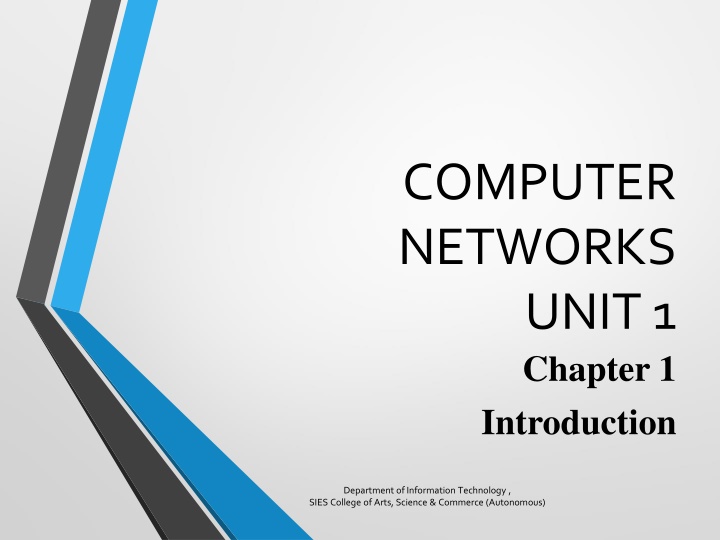
Understanding Data Communications and Computer Networks Fundamentals
Explore the basics of data communications and computer networks, covering topics such as delivery, accuracy, timeliness, and jitter. Learn about the components involved in communication systems and the importance of protocols for effective data transmission.
Download Presentation

Please find below an Image/Link to download the presentation.
The content on the website is provided AS IS for your information and personal use only. It may not be sold, licensed, or shared on other websites without obtaining consent from the author. If you encounter any issues during the download, it is possible that the publisher has removed the file from their server.
You are allowed to download the files provided on this website for personal or commercial use, subject to the condition that they are used lawfully. All files are the property of their respective owners.
The content on the website is provided AS IS for your information and personal use only. It may not be sold, licensed, or shared on other websites without obtaining consent from the author.
E N D
Presentation Transcript
COMPUTER NETWORKS UNIT 1 Chapter 1 Introduction Department of Information Technology , SIES College of Arts, Science & Commerce (Autonomous)
DATA COMMUNICATIONS Data communications are the exchange of data between two devices via some form of transmission medium such as a wire cable. For data communications to occur, the communicating devices must be part of a communication system made up of a combination of hardware (physical equipment) and software (programs). The effectiveness of a data communications system depends on four fundamental characteristics: delivery, accuracy, timeliness, and jitter. Department of Information Technology , SIES College of Arts, Science & Commerce (Autonomous)
1. Delivery. The system must deliver data to the correct destination. Data must be received by the intended device or user and only by that device or user. 2. Accuracy. The system must deliver the data accurately. Data that have been altered in transmission and left uncorrected are unusable. 3. Timeliness. The system must deliver data in a timely manner. Data delivered late are useless. In the case of video and audio, timely delivery means delivering data as they are produced, in the same order that they are produced, and without significant delay. This kind of delivery is called real-time transmission. 4. Jitter. Jitter refers to the variation in the packet arrival time. It is the uneven delay in the delivery of audio or video packets. For example, let us assume that video packets are sent every 30 ms. If some of the packets arrive with 30-ms delay and others with 40-ms delay, an uneven quality in the video is the result. Department of Information Technology , SIES College of Arts, Science & Commerce (Autonomous)
Components 1. Message. The message is the information (data) to be communicated. Popular forms of information include text, numbers, pictures, audio, and video. 2. Sender. The sender is the device that sends the data message. It can be a computer, workstation, telephone handset, video camera, and so on. Department of Information Technology , SIES College of Arts, Science & Commerce (Autonomous)
3. Receiver. The receiver is the device that receives the message. It can be a computer, workstation, telephone handset, television, and so on. 4. Transmission medium. The transmission medium is the physical path by which a message travels from sender to receiver. Some examples of transmission media include twisted-pair wire, coaxial cable, fiber-optic cable, and radio waves. 5. Protocol. A protocol is a set of rules that govern data communications. It represents an agreement between the communicating devices. Without a protocol, two devices may be connected but not communicating, just as a person speaking French cannot be understood by a person who speaks only Japanese. Department of Information Technology , SIES College of Arts, Science & Commerce (Autonomous)
Department of Information Technology , SIES College of Arts, Science & Commerce (Autonomous)
Data Representation Information today comes in different forms such as text, numbers, images, audio, and video. Text In data communications, text is represented as a bit pattern, a sequence of bits (0s or 1s). Different sets of bit patterns have been designed to represent text symbols Numbers Numbers are also represented by bit patterns. However, a code such as ASCII is not used to represent numbers; the number is directly converted to a binary number to simplify mathematical operations. Department of Information Technology , SIES College of Arts, Science & Commerce (Autonomous)
Images Images are also represented by bit patterns. In its simplest form, an image is composed of a matrix of pixels (picture elements), where each pixel is a small dot. The size of the pixel depends on the resolution. There are several methods to represent color images. One method is called RGB. Another method is called YCM. Audio Audio refers to the recording or broadcasting of sound or music. Audio is by nature different from text, numbers, or images. It is continuous, not discrete. Department of Information Technology , SIES College of Arts, Science & Commerce (Autonomous)
Video Video refers to the recording or broadcasting of a picture or movie. Video can either be produced as a continuous entity (e.g., by a TV camera), or it can be a combination of images, each a discrete entity, arranged to convey the idea of motion. Department of Information Technology , SIES College of Arts, Science & Commerce (Autonomous)
Data Flow Department of Information Technology , SIES College of Arts, Science & Commerce (Autonomous)
Simplex In simplex mode, the communication is unidirectional, as on a one-way street. Only one of the two devices on a link can transmit; the other can only receive. Keyboards and traditional monitors are examples of simplex devices. Half-Duplex In half-duplex mode, each station can both transmit and receive, but not at the same time. When one device is sending, the other can only receive, and vice versa. The half-duplex mode is like a one-lane road with traffic allowed in both directions. When cars are traveling in one direction, cars going the other way must wait. of Arts, Science & Commerce (Autonomous) Department of Information Technology , SIES College
Full-Duplex In full-duplex mode (also called duplex), both stations can transmit and receive simultaneously. The full-duplex mode is like a two-way street with traffic flowing in both directions at the same time. In full-duplex mode, signals going in one direction share the capacity of the link with signals going in the other direction. One common example of full-duplex communication is the telephone network. When two people are communicating by a telephone line, both can talk and listen at the same time. Department of Information Technology , SIES College of Arts, Science & Commerce (Autonomous)
NETWORKS A network is the interconnection of a set of devices capable of communication. In this definition, a device can be a host (or an end system as it is sometimes called) such as a large computer, desktop, laptop, workstation, cellular phone, or security system. A device in this definition can also be a connecting device such as a router, which connects the network to other networks, a switch, which connects devices together, a modem (modulator- demodulator), which changes the form of data, and so on. Department of Information Technology , SIES College of Arts, Science & Commerce (Autonomous)
Network Criteria A network must be able to meet a certain number of criteria. The most important of these are performance, reliability, and security. Department of Information Technology , SIES College of Arts, Science & Commerce (Autonomous)
Performance Performance can be measured in many ways, including transit time and response time. Transit time is the amount of time required for a message to travel from one device to another. Response time is the elapsed time between an inquiry and a response. The performance of a network depends on a number of factors, including the number of users, the type of transmission medium, the capabilities of the connected hardware, and the efficiency of the software. Performance is often evaluated by two networking metrics: throughput and delay. Department of Information Technology , SIES College of Arts, Science & Commerce (Autonomous)
Reliability In addition to accuracy of delivery, network reliability is measured by the frequency of failure, the time it takes a link to recover from a failure, and the network s robustness in a catastrophe. Security Network security issues include protecting data from unauthorized access, protecting data from damage and development, and implementing policies and procedures for recovery from breaches and data losses. Department of Information Technology , SIES College of Arts, Science & Commerce (Autonomous)
Physical Structures Type of Connection A network is two or more devices connected through links. A link is a communications pathway that transfers data from one device to another. There are two possible types of connections: point-to-point and multipoint. Point-to-Point A point-to-point connection provides a dedicated link between two devices. The entire capacity of the link is reserved for transmission between those two devices. Department of Information Technology , SIES College of Arts, Science & Commerce (Autonomous)
Multipoint A multipoint (also called multidrop) connection is one in which more than two specific devices share a single link. Department of Information Technology , SIES College of Arts, Science & Commerce (Autonomous)
Department of Information Technology , SIES College of Arts, Science & Commerce (Autonomous)
Physical Topology The term physical topology refers to the way in which a network is laid out physically. Two or more devices connect to a link; two or more links form a topology. The topology of a network is the geometric representation of the relationship of all the links and linking devices (usually called nodes) to one another. There are four basic topologies possible: mesh, star, bus, and ring. Department of Information Technology , SIES College of Arts, Science & Commerce (Autonomous)
Mesh Topology In a mesh topology, every device has a dedicated point- to-point link to every other device. Mesh topology, we need n (n 1) / 2 duplex-mode links. Advantages:- Use of dedicated links Robust Privacy & Security Disadvantages:- Amount of cabling & number of I/O ports required. Department of Information Technology , SIES College of Arts, Science & Commerce (Autonomous)
Star Topology In a star topology, each device has a dedicated point-to-point link only to a central controller, usually called a hub. The controller acts as an exchange: If one device wants to send data to another, it sends the data to the controller, which then relays the data to the other connected device. Advantages:- Less expensive than a mesh topology Easy to install and reconfigure Robustness Disadvantages:- Dependency on one single point Department of Information Technology , SIES College of Arts, Science & Commerce (Autonomous)
Bus Topology Multipoint One long cable acts as a backbone to link all the devices in a network. A drop line is a connection running between the device and the main cable. Advantages:- Ease of installation Disadvantages:- Difficult reconnection & fault isolation Department of Information Technology , SIES College of Arts, Science & Commerce (Autonomous)
Ring Topology In a ring topology, each device has a dedicated point-to-point connection with only the two devices on either side of it. A signal is passed along the ring in one direction, from device to device, until it reaches its destination. Advantages:- Easy to install and reconfigure Disadvantages:- Unidirectional traffic Department of Information Technology , SIES College of Arts, Science & Commerce (Autonomous)
NETWORK TYPES Local Area Network A local area network (LAN) is usually privately owned and connects some hosts in a single office, building, or campus. Each host in a LAN has an identifier, an address, that uniquely defines the host in the LAN. Today, most LANs use a smart connecting switch, which is able to recognize the destination address of the packet and guide the packet to its destination without sending it to all other hosts. Department of Information Technology , SIES College of Arts, Science & Commerce (Autonomous)
Department of Information Technology , SIES College of Arts, Science & Commerce (Autonomous)
Wide Area Network A wide area network (WAN) is also an interconnection of devices capable of communication. A LAN is normally limited in size, spanning an office, a building, or a campus; a WAN has a wider geographical span, spanning a town, a state, a country, or even the world. A LAN interconnects hosts; a WAN interconnects connecting devices such as switches, routers, or modems. Department of Information Technology , SIES College of Arts, Science & Commerce (Autonomous)
Department of Information Technology , SIES College of Arts, Science & Commerce (Autonomous)
Department of Information Technology , SIES College of Arts, Science & Commerce (Autonomous)
Point-to-Point WAN A point-to-point WAN is a network that connects two communicating devices through a transmission media (cable or air). Switched WAN A switched WAN is a network with more than two ends. Internetwork When two or more networks are connected, they make an internetwork, or internet. Department of Information Technology , SIES College of Arts, Science & Commerce (Autonomous)
Switching Circuit-Switched Network In a circuit-switched network, a dedicated connection, called a circuit, is always available between the two end systems; the switch can only make it active or inactive. Packet-Switched Network In a computer network, the communication between the two ends is done in blocks of data called packets. In other words, instead of the continuous communication we see between two telephone sets when they are being used, we see the exchange of individual data packets between the two computers. Department of Information Technology , SIES College of Arts, Science & Commerce (Autonomous)






